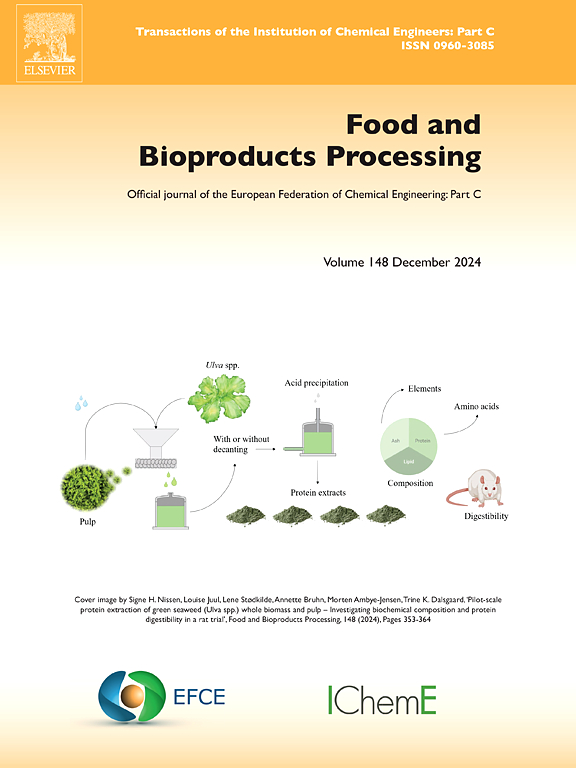Impact of hydroethanolic extracts from Guaco leaves (Mikania glomerata Sprengel) on mechanical properties and bioactivities of gelatin-based bioactive films
IF 3.4
2区 农林科学
Q2 BIOTECHNOLOGY & APPLIED MICROBIOLOGY
引用次数: 0
Abstract
Guaco leaves (Mikania glomerata Sprengel) show potential as a source of phenolic compounds (PC) that can be extracted for application in active film production. The phenolic profile of guaco leaf hydroethanolic extracts (GLHE) and their impact on the properties of the gelatin-glycerol film-forming solutions (FFS) and films were evaluated. GLHE were prepared using 20 (GLHE.20), 40 (GLHE.40), and 60 % (v/v) ethanol (GLHE.60), and incorporated into gelatin FFS at concentrations of 50 or 150 (g/100 g gelatin). The phenolic profile of GLHE was determined by untargeted metabolomics. The FFS and their films were characterized. Phenolic acids and flavonoids comprised 75 % of the PC and significantly influenced the phenolic profile of the extracts. Multivariate analyses suggested that derivatives of caffeic and coumaric acids, along with various flavonoids, contributed to the strong antioxidant activity of GLHE.40 and GLHE.60. The addition of these extracts into films did not affect their microstructure, crystallinity, thickness, moisture content, solubility in water, and opacity. On the other hand, thermal properties, water contact angle, water vapor permeability, mechanical properties, and color parameters. Moreover, the addition of GLHE increased the antioxidant activity (AoA) of the material, without, however, conferring antimicrobial activity against Gram-positive or Gram-negative bacteria. A good stability of the AoA within the gelatin matrix was observed over a six-month period. Overall, the type of solvent affected the films’ tensile strength (TS) (GLHE.20 <GLHE.40 <GLHE.60) but regarding the GLHE concentration, only 150 % sample increased TS as compared with the control films. In conclusion, the Guaco leaf extracts are rich in phenolic compounds with good bioactivity and can be used in the production of active films based on gelatin.
番石榴叶水乙醇提取物对明胶基生物活性膜力学性能和生物活性的影响
番石榴叶(Mikania glomerata Sprengel)显示出作为酚类化合物(PC)的潜在来源,可以提取用于活性膜的生产。研究了瓜果叶氢乙醇提取物(GLHE)的酚类特征及其对明胶-甘油成膜液(FFS)和成膜性能的影响。用20 (GLHE.20)、40 (GLHE.40)和60 % (v/v)乙醇(GLHE.60)制备GLHE,并以50或150 (g/100 g明胶)的浓度掺入明胶FFS中。GLHE的酚类特征通过非靶向代谢组学测定。并对FFS及其薄膜进行了表征。酚酸和黄酮类化合物占PC的75% %,对提取物的酚类成分有显著影响。多因素分析表明,咖啡酸和香豆酸衍生物以及多种黄酮类化合物对GLHE.40和GLHE.60具有较强的抗氧化活性有贡献。在薄膜中加入这些提取物对薄膜的微观结构、结晶度、厚度、含水量、水溶性和不透明度没有影响。另一方面,热性能、水接触角、水蒸气渗透性、机械性能和颜色参数。此外,GLHE的加入增加了材料的抗氧化活性(AoA),然而,没有赋予对革兰氏阳性或革兰氏阴性细菌的抗菌活性。在六个月的时间里,在明胶基质中观察到AoA的良好稳定性。总体而言,溶剂类型影响薄膜的抗拉强度(TS) (GLHE.20 <;GLHE.40 <;GLHE.60),但就GLHE浓度而言,只有15 %的样品比对照膜增加了TS。综上所述,番石榴叶提取物富含酚类化合物,具有良好的生物活性,可用于明胶活性膜的制备。
本文章由计算机程序翻译,如有差异,请以英文原文为准。
求助全文
约1分钟内获得全文
求助全文
来源期刊

Food and Bioproducts Processing
工程技术-工程:化工
CiteScore
9.70
自引率
4.30%
发文量
115
审稿时长
24 days
期刊介绍:
Official Journal of the European Federation of Chemical Engineering:
Part C
FBP aims to be the principal international journal for publication of high quality, original papers in the branches of engineering and science dedicated to the safe processing of biological products. It is the only journal to exploit the synergy between biotechnology, bioprocessing and food engineering.
Papers showing how research results can be used in engineering design, and accounts of experimental or theoretical research work bringing new perspectives to established principles, highlighting unsolved problems or indicating directions for future research, are particularly welcome. Contributions that deal with new developments in equipment or processes and that can be given quantitative expression are encouraged. The journal is especially interested in papers that extend the boundaries of food and bioproducts processing.
The journal has a strong emphasis on the interface between engineering and food or bioproducts. Papers that are not likely to be published are those:
• Primarily concerned with food formulation
• That use experimental design techniques to obtain response surfaces but gain little insight from them
• That are empirical and ignore established mechanistic models, e.g., empirical drying curves
• That are primarily concerned about sensory evaluation and colour
• Concern the extraction, encapsulation and/or antioxidant activity of a specific biological material without providing insight that could be applied to a similar but different material,
• Containing only chemical analyses of biological materials.
 求助内容:
求助内容: 应助结果提醒方式:
应助结果提醒方式:


